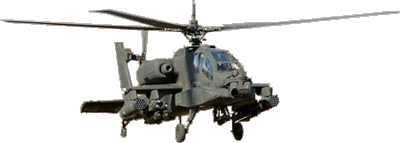|
|

|
|
The AH-64A proved its capabilities in action during both Operation Restore Hope and Operation Desert Storm. Apache helicopters played a key role in the 1989 action in Panama, where much of its activity was at night, when the AH-64's advanced sensors and sighting systems were effective against Panamanian government forces. Apache helicopters also played a major role in the liberation of Kuwait. On 20 November 1990, the 11th Aviation Brigade was alerted for deployment to Southwest Asia from Storck Barracks in Illesheim Germany. The first elements arrived in theater 24 November 1990. By 15 January 1991 the unit had moved 147 helicopters, 325 vehicles and 1,476 soldiers to the region. The Apache helicopters of the Brigade destroyed more than 245 enemy vehicles with no losses. During Operation Desert Storm, AH-64s were credited with destroying more than 500 tanks plus hundreds of additional armored personnel carriers, trucks and other vehicles. They also were used to destroy vital early warning radar sites, an action that opened the U.N. coalition's battle plan. Apaches also demonstrated the ability to perform when called upon, logging thousands of combat hours at readiness rates in excess of 85 percent during the Gulf War. While recovery was ongoing, additional
elements of the 11th Aviation Brigade began the next chapter
of involvement in the region. On 24 April 1991 the 6th Squadron,
6th Cavalry’s 18 AH-64 helicopters began a self-deployment
to Southwest Asia. The Squadron provided aerial security to a
3,000 square kilometer region in Northern Iraq as part of the
Combined Task Force of Operation Provide Comfort. Army National Guard units in North and South Carolina, Florida, Texas, Arizona, Utah and Idaho also fly Apache helicopters. The Army has fielded combat-ready AH-64A units in the United States, West Germany and in Korea, where they play a major role in achieving the US Army's security missions. The Apache is clearly one of the most dynamic and important programs in aviation and the Army, but it is not without limitations. Due to the possibility of surging the engines, pilots have been instructed not to fire rockets from in-board stations. According to current doctrine, they are to fire no more than pairs with two outboard launchers every three seconds, or fire with only one outboard launcher installed without restrictions (ripples permitted). These are the only conditions permitted. Other firing conditions will be required to be approved via a System Safety Risk Assessment (SSRA). The improvement of aircraft systems troubleshooting is a high priority issue for O&S Cost reduction. Because of funding cuts, the level of contractor support to the field has been reduced. This results in higher costs in no fault found removals, maintenance man hours, and aircraft down time. The Apache PM, US Army Aviation Logistics School, and Boeing are currently undertaking several initiatives. Upgrading and improving the soldier's ability to quickly and accurately fault isolate the Apache weapons system is and will continue to be an O&S priority until all issues are resolved. Prime Vendor Support (PVS) for the entire fleet of AH-64s is a pilot program for the Army, and may become a pilot program for the Department of Defense. PVS will place virtually all of Apache's wholesale logistic responsibility under a single contract. The Apache flying hour program will provide upfront funding for spares, repairables, contractor technical experts, and reliability improvements. Starting at the flight line there will be contractor expert technicians with advanced troubleshooting capability assigned to each Apache Battalion. At the highest level, PVS represents a single contractor focal point for spares and repairs. The intent is to break the current budget and requirements cycle that has Apache at 67% supply availability with several thousand lines at zero balance. Modernization Through Spares (MTS) is a spares/component improvement strategy applied throughout the acquisition life cycle and is based on technology insertion to enhance systems and extend useful life while reducing costs. The MTS initiative seeks to leverage current procurement funds and modernize individual system spares thereby incrementally improving these systems. MTS is accomplished via the "spares" acquisition process. MTS, a subset of acquisition reform, seeks to improve an end item's spare components. The emphasis is on form, fit and function, allowing a supplier greater design and manufacturing flexibility to exploit technology used in the commercial marketplace. Apache MTS focuses on the insertion of the latest technology into the design and manufacture of select spares. This is to be accomplished without government research and development (R&D) funds, but rather, uses industry investment. Industry, in turn, recoups this investment through the sale of improved hardware via long term contracts. Modernization efforts continue to improve the performance envelope of the AH-64A while reducing the cost of ownership. Major modernization efforts within the AH-64A fleet are funded and on schedule. GG Rotor modifications were finished in April 1998,, and future improvements such as a Second Generation FLIR, a High Frequency Non-Line of Sight NOE radio, and an internal fully crashworthy auxiliary fuel tank are all on the verge of becoming a reality for the Apache. The Aviation Mission Planning System (AMPS) and the Data Transfer Cartridge (DTC) are tools for the Embedded Global Positioning Inertial Navigation Unit (EGI) equipped AH-64A aircraft that allow aircrews to plan missions and download the information to a DTC installed in the Data Transfer Receptacle (DTR). This saves the pilots a lot of "fat fingering" and eliminates the worry of everyone being on the same "sheet of music". Other features of the DTC include; saving waypoints and targets and troubleshooting. The EGI program is a Tri-service program with the Army, Air Force and Navy. |
|||||||||||||||||||||||||||
|
Ah-64A Specifications
|
[ HOME ] [ AH-64A ] [ AH-64D ] [ Longbow ] [ WAH-64] [ Info ] [ Armament ]
[ Pictures ] [ Video ] [ IHADSS ] [ Links ]

